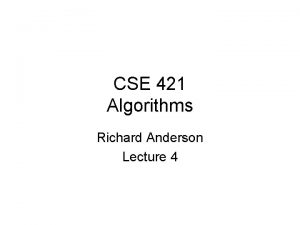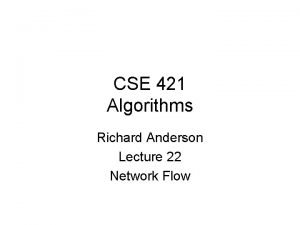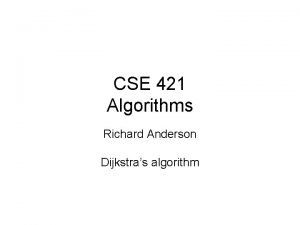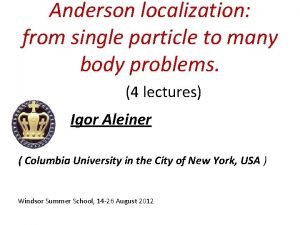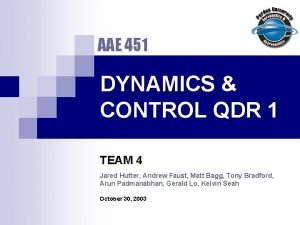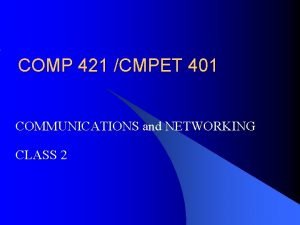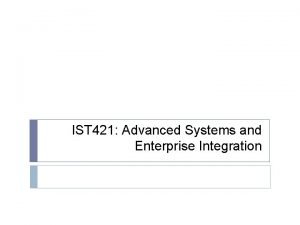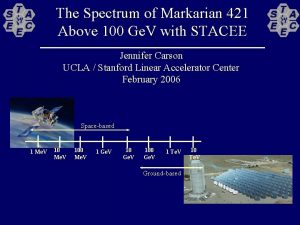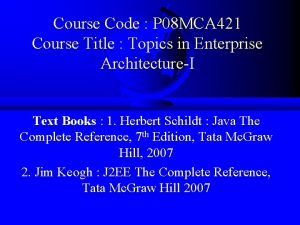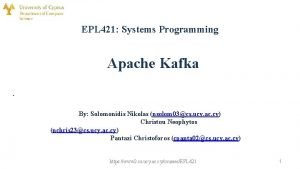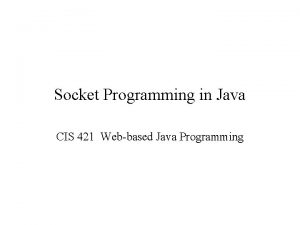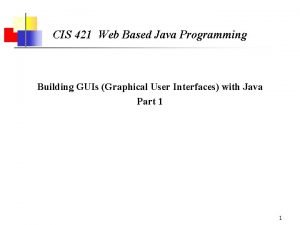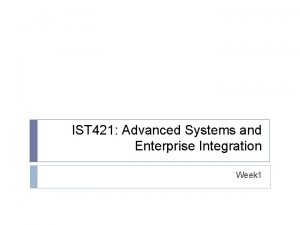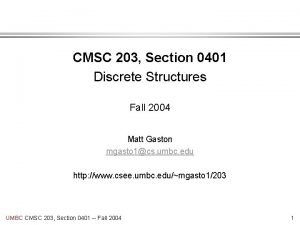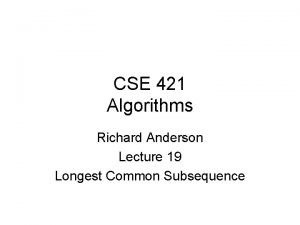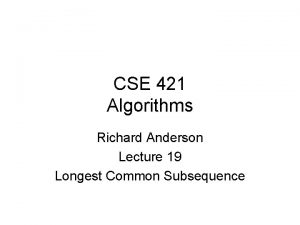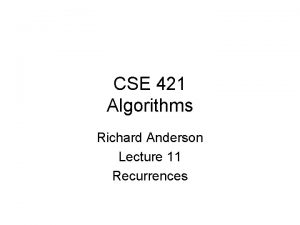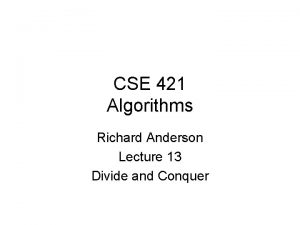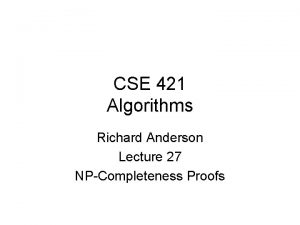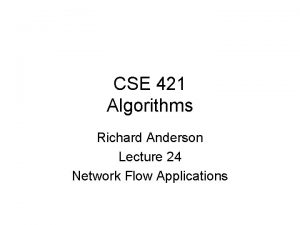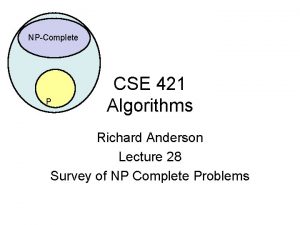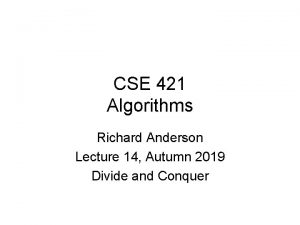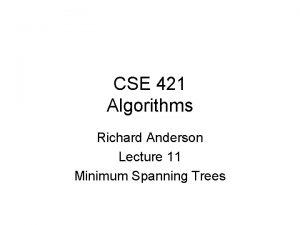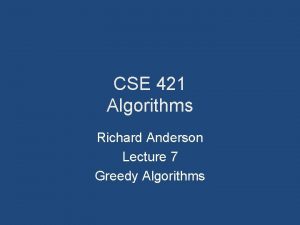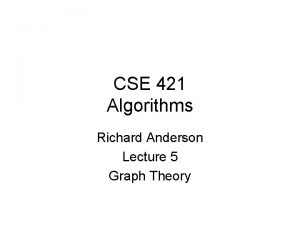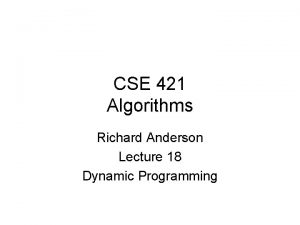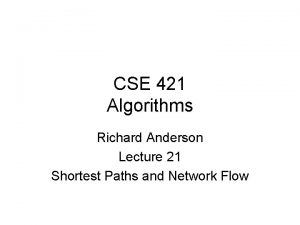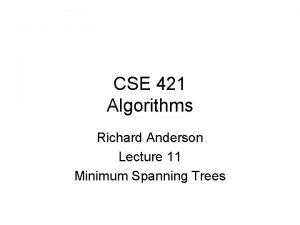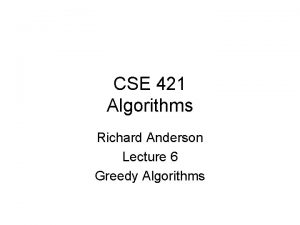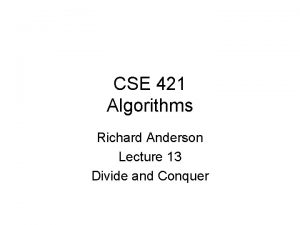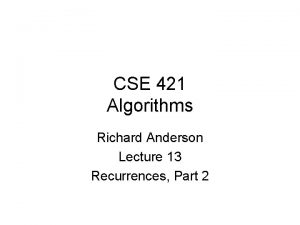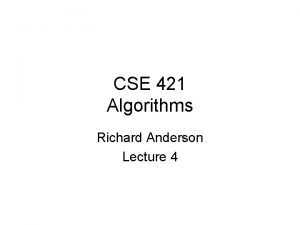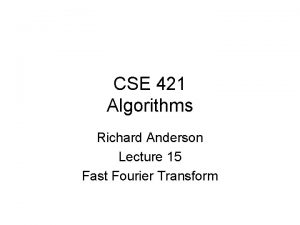CSE 421 Algorithms Richard Anderson Lecture 19 Longest





![Optimization recurrence If aj = bk, Opt[ j, k ] = 1 + Opt[ Optimization recurrence If aj = bk, Opt[ j, k ] = 1 + Opt[](https://slidetodoc.com/presentation_image_h2/77d578bd50762bb9d2b31ca5c7c9ba01/image-6.jpg)


![Code to compute Opt[j, k] Code to compute Opt[j, k]](https://slidetodoc.com/presentation_image_h2/77d578bd50762bb9d2b31ca5c7c9ba01/image-9.jpg)
![A[1. . m], B[1. . n] for i : = 1 to m Opt[i, A[1. . m], B[1. . n] for i : = 1 to m Opt[i,](https://slidetodoc.com/presentation_image_h2/77d578bd50762bb9d2b31ca5c7c9ba01/image-10.jpg)












- Slides: 22

CSE 421 Algorithms Richard Anderson Lecture 19 Longest Common Subsequence

Longest Common Subsequence • C=c 1…cg is a subsequence of A=a 1…am if C can be obtained by removing elements from A (but retaining order) • LCS(A, B): A maximum length sequence that is a subsequence of both A and B ocurranec attacggct occurrence tacgacca

Determine the LCS of the following strings BARTHOLEMEWSIMPSON KRUSTYTHECLOWN

String Alignment Problem • Align sequences with gaps CAT TGA AT CAGAT AGGA • Charge dx if character x is unmatched • Charge gxy if character x is matched to character y Note: the problem is often expressed as a minimization problem, with gxx = 0 and dx > 0

LCS Optimization • A = a 1 a 2…am • B = b 1 b 2…bn • Opt[ j, k] is the length of LCS(a 1 a 2…aj, b 1 b 2…bk)
![Optimization recurrence If aj bk Opt j k 1 Opt Optimization recurrence If aj = bk, Opt[ j, k ] = 1 + Opt[](https://slidetodoc.com/presentation_image_h2/77d578bd50762bb9d2b31ca5c7c9ba01/image-6.jpg)
Optimization recurrence If aj = bk, Opt[ j, k ] = 1 + Opt[ j-1, k-1 ] If aj != bk, Opt[ j, k] = max(Opt[ j-1, k], Opt[ j, k-1])

Give the Optimization Recurrence for the String Alignment Problem • Charge dx if character x is unmatched • Charge gxy if character x is matched to character y Opt[ j, k] = Let aj = x and bk = y Express as minimization

Dynamic Programming Computation
![Code to compute Optj k Code to compute Opt[j, k]](https://slidetodoc.com/presentation_image_h2/77d578bd50762bb9d2b31ca5c7c9ba01/image-9.jpg)
Code to compute Opt[j, k]
![A1 m B1 n for i 1 to m Opti A[1. . m], B[1. . n] for i : = 1 to m Opt[i,](https://slidetodoc.com/presentation_image_h2/77d578bd50762bb9d2b31ca5c7c9ba01/image-10.jpg)
A[1. . m], B[1. . n] for i : = 1 to m Opt[i, 0] : = 0; for j : = 1 to n Opt[0, j] : = 0; b 1…bn Storing the path information Opt[0, 0] : = 0; a 1…am for i : = 1 to m for j : = 1 to n if A[i] = B[j] { Opt[i, j] : = 1 + Opt[i-1, j-1]; Best[i, j] : = Diag; } else if Opt[i-1, j] >= Opt[i, j-1] { Opt[i, j] : = Opt[i-1, j], Best[i, j] : = Left; } else { Opt[i, j] : = Opt[i, j-1], Best[i, j] : = Down; }

How good is this algorithm? • Is it feasible to compute the LCS of two strings of length 100, 000 on a standard desktop PC? Why or why not.

Observations about the Algorithm • The computation can be done in O(m+n) space if we only need one column of the Opt values or Best Values • The algorithm can be run from either end of the strings

Computing LCS in O(nm) time and O(n+m) space • Divide and conquer algorithm • Recomputing values used to save space

Divide and Conquer Algorithm • Where does the best path cross the middle column? • For a fixed i, and for each j, compute the LCS that has ai matched with bj

Constrained LCS • LCSi, j(A, B): The LCS such that – a 1, …, ai paired with elements of b 1, …, bj – ai+1, …am paired with elements of bj+1, …, bn • LCS 4, 3(abbacbb, cbbaa)

A = RRSSRTTRTS B=RTSRRSTST Compute LCS 5, 0(A, B), LCS 5, 1(A, B), …, LCS 5, 9(A, B)

A = RRSSRTTRTS B=RTSRRSTST Compute LCS 5, 0(A, B), LCS 5, 1(A, B), …, LCS 5, 9(A, B) j left right 0 0 4 1 1 4 2 1 3 3 2 3 4 3 3 5 3 2 6 3 2 7 3 1 8 4 1 9 4 0

Computing the middle column • From the left, compute LCS(a 1…am/2, b 1…bj) • From the right, compute LCS(am/2+1…am, bj+1…bn) • Add values for corresponding j’s • Note – this is space efficient

Divide and Conquer • A = a 1, …, am • Find j such that B = b 1, …, bn – LCS(a 1…am/2, b 1…bj) and – LCS(am/2+1…am, bj+1…bn) yield optimal solution • Recurse

Algorithm Analysis • T(m, n) = T(m/2, j) + T(m/2, n-j) + cnm

Prove by induction that T(m, n) <= 2 cmn

Memory Efficient LCS Summary • We can afford O(nm) time, but we can’t afford O(nm) space • If we only want to compute the length of the LCS, we can easily reduce space to O(n+m) • Avoid storing the value by recomputing values – Divide and conquer used to reduce problem sizes
 Uw cse 421
Uw cse 421 Cse 421
Cse 421 Cse 421
Cse 421 Anderson localization lecture notes
Anderson localization lecture notes Analysis of algorithms lecture notes
Analysis of algorithms lecture notes Introduction to algorithms lecture notes
Introduction to algorithms lecture notes Richard anderson york university
Richard anderson york university Richard dean anderson hockey
Richard dean anderson hockey 01:640:244 lecture notes - lecture 15: plat, idah, farad
01:640:244 lecture notes - lecture 15: plat, idah, farad King richard iii and looking for richard
King richard iii and looking for richard Aae 421
Aae 421 Comp 421
Comp 421 Ist 421
Ist 421 Cs 421 programming languages and compilers
Cs 421 programming languages and compilers Markarian 421 transmission
Markarian 421 transmission Fwm 421
Fwm 421 Epl421
Epl421 Single pass and multi pass heat exchanger
Single pass and multi pass heat exchanger 421 could not create socket
421 could not create socket Jrootpane
Jrootpane Ist 421
Ist 421 421 rule
421 rule Cmsc 421 umbc
Cmsc 421 umbc
